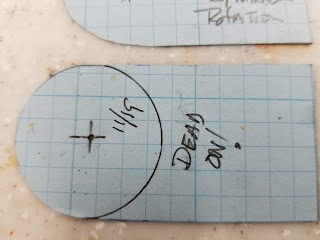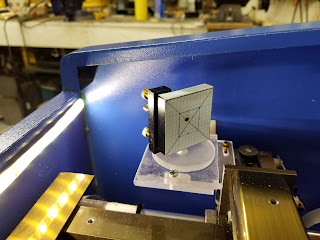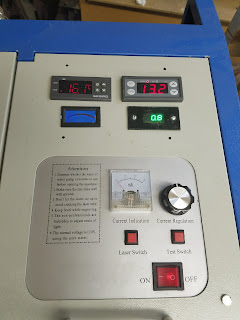Reading the Tea Leaves
DRAFT VERSION 11/21/19
In previous related posts I outlined the upgrade of mirror 1-2 mounts and introduced a set of target holders intended to make optical alignment simpler.
There are 4 posts that pertain to improving optical components and alignment:
Improving mirror #1
Improving mirror #2
K40 optical alignment tool theory & design
Using K40 alignment tools
In this post I will show the results of my first tests while outlining how these tools are intended to be used for aligning your K40.
Donate:
Please consider donating (button to the right of this post).
Your donations help fund additional research, tools and parts that I will return to the community as information.
Introduction to alignment with the KlineWorks K40 Tools
This concept can seem pretty complex at first but with a little study it becomes intuitive.
The motivation to build the K40 alignment tools came from the notion that to properly align an optical system the beam position throughput its path needed to be seen in three dimensions. The diagram below illustrated that concept.
The idea is to move graduated targets along the axis of the beam referenced to a surface that is the same as the axis the laser head is referenced to.
Reference Surfaces
In the K40, these references are the Y axis gantry and the X axis gantry. Once the target holders are made the reference surface can be ignored as the targets are placed into their holders and the holders are sitting referenced to the Y and X gantries respectively.
Z Position
The Z axis is represented by the placement of the target along the beams path. We will use the following nomenclature to identify values @ various positions:
x,y = [x position on target], [y position on target (from the targets reference point)]
(axis)(position #); where [axis = either X or Y], [position # = the # representing the targets placement along the optical path]
example: X(3) = 22; [the x value of a target placed @ position #3 = 22]
Targets Holders & Targets
The targets are graduated and held to the reference surfaces with in a slot. Since the target holders position the target accurately to a reference we simply need to analyze the difference in a beams placement on the target from one Z position to another. The targets are moved along the Z axis, burned and then the position in X & Y on the target shows the error in the respective axis.
Example Interpretation
The target samples shown below are from position #1 and position #2 along the Y gantry axis. Lets examine what they are telling us:
Describing The Target Artifacts
First off lets define the static artifacts of the targets:
- The graduated side of this target is facing the front of the machine
- These light graduations are 1/8" (.125") resolution and the dark are groups of 5 @5/8 (.625).
- The right side is a reliable place to count X position from
- The bottom is the reference to the Y gantry and is a reliable place to count Y position from
- The circle is a rough representation of where the burn will show up. Note this circle is not intended to be accurately placed around the proper center position of the beam. It is for a visual reference only. However it looks like I got pretty close.
Reading the Error Between Two Positions
Position #1
Counting from the right to the burn mark we can set the X1 position to 21 graduations
Counting from the bottom to the burn mark we set the Y1 position to 17 graduations.
The burn @ target position #1 is therefor x,y = 21,17
Position #2
Using the same counting method as position #1 we can set the beams position at position #2 x,y = 20, 17
So what does this mean?
X1 = 21, X2 = 20: this means that the beam is travelling from left to right [as viewed from machine top] as it exits position 1 and hits position #2. In the X plane it is travelling at an angle of 1/8" over about 8.5". We could calculate the angle but that would only have academic value.
Y1 = 17, Y2 = 17; this means that the beam has no error in the Y direction :)! Meaning as the beam traverses from position #1 to position #2 it is has no up[toward top of machine] or down[toward bottom of machine] error. It is moving parallel to the Y axis of the machines gantry.
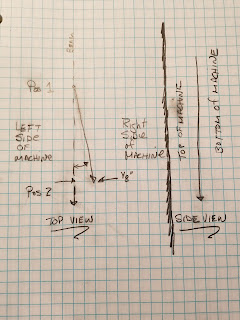 |
| A visual representation of the error |
What would I correct?
Lets keep this simple though. Instead of trying to visualize all the axis described above all one needs to know is that the beam is not perfectly straight and adjustment if any should be in the -X direction on mirror #1 without any change to the Y.
A simple approach to viewing the error, is to overlay one positions target over another. Then mark the second charts hole onto the first target showing the error.
When viewed this way the error is simple to see and in actuality the beam is moving slightly to the right and slightly down. The difference in what you see here and the X/Y positions I counted above is the resolution of the graph.
Looks like the actual error in X and Y is closer to 1/16" over 8.5 ". The error is z,y = .0625,.0625
A Total Alignment Scenario
Lets take what we have learned from above and apply it to a total alignment. Lets examine the beam from mirror #1 to the materials surface. Lets make the entire optical path appear linear by laying all the burned targets into a line. Yes we are changing axis as we move down the Y gantry and fold to the X gantry but for alignment purposes we will just watch the error from one target to the other.
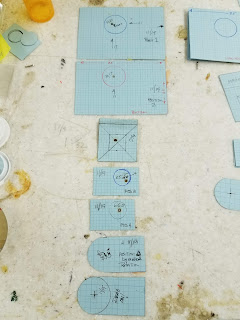 |
| All targets positioned vertically... |
Before going on to the next section zoom in on the above photo and orient your thinking.
Mirror #1 position
No target avail for this one yet.
Mirror #2 Position
The target for mirror #1,2 are different than the other targets. They hang on the mirror and intent to show where the beam is hitting relative to the mirrors center. The target is registered to the left mirror mounts surface and a box defines the mirrors aperture [which is actually round].
We see that the beam is hitting in the upper left quadrant of the aperture about 1/8 above and left of center.
Since the beam coming from mirror 1 is actually moving slightly down you would expect the beam to hit the mirror below the center. My guess is that the reason it is hitting mirror #2 high is that one or both of the homemade mirror mounts [#1,#2] are vertically not exactly in the right position vs where it should be, after all I did guess at the dimensions.
Since the beam coming from mirror #1 is pointing slightly down (1/16) I should lower that mount and then tilt the mirror up (1/16) until it hits center on mirror #2 ... Remember that a small change in mirror #1 position will be quite large by the time it hits mirror #2.
This is a good example of how these targets show what is really going on.
For the X error if I tilt mirror # 1 to the right [as seen from the back] I should be able to straighten the path and hit mirror # 2 in the center.
Or call this good and move on :)
Target Position #3
Target position #3 is the leftmost position on the X gantry. This will capture the beam as it exits mirror #2 and proceeds to mirror #3.
A different target holder is used that straddles the X gantry and is fixed in place with a thumb screw. This holder uses a smaller target that is referenced to the bottom and right of the holder.
Keep in mind that the circle is a rough approximation of the area where the beam may be and is simply a visual reference. The center of this circle is not the center of the objective head's mirror.
 |
| target at position # 3 xy= 4.5, 5 [error in annotation on chart] |
We see that the beam is in the lower right quadrant of the relative circles position. At this point its position is interesting but not informative.
Target Position #4
The beam hits the target at xy= 5.5, 6.5. This tells us that the beam is reflected off mirror #2 at an angle that is left-upward i.e. up and toward the back of the machine. The beam from mirror #2 to mirror # 3 is not straight.
Although the circle does not exactly represent the center of mirror #3 I suspect that its real center is pretty close. I am guessing that the beam is hitting mirror at an angle and slightly +X.
Mirror #3 Position
I am going to add a target placed on the mirror #3
Position #4
Position #4 is the hardest location to get aligned but also the most important. As the beam hits mirror #3 and is reflected at a fixed 45 degrees it must enter the center of the objective lens. If the beam is not perpendicular to the surface and in the center of the objective lens it will exit the lens at an angle and hit the side of the lens mount or air assist nozzle. The the only adjustment on head is the rotation of the entire head which can effect the centering of the beam on the lens.
The final target is placed into the tube target holder and slid over the heads cylinder. The intention is to see if the beam exits centered relative to the cylinder.
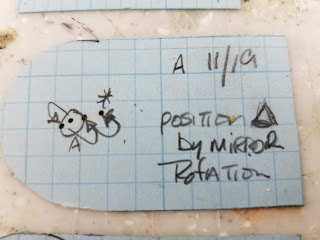 |
| moving the beam by rotating the head assembly |
At first try the beam hit well off center (the*). I rotated the head which resulted in moving beam (see series of dots) until it was in the center.
Replacing the target with a fresh one and re-burning shows that the beam is in the center of the objective lens's area.
While writing this post I realize that the beam can be in the center at a certain point at the surface but still not be perpendicular to the surface. I need two point along the beam as it exits the objective lens. If we don't prove the beam is perpendicular the beam can be at a different center line for differing focal lengths.
Next Steps:
- Test for stability; how long will an alignment hold with the new mounts.
- Add a target on mirror #3's mount and accurately position its aperture.
- Add another target position after the objective lens.
- Investigate a new head design that allows for adjustment of mirror #3.
Summary so far
Evidence is that these tools and associated alignment technique work to visualize errors in the beam as it traverses its intended optical path. Is this a more accurate and simpler method than just putting targets on mirrors? Time will tell but for me this adds definitive measurements and better visualization of how the optical path traverses the machine. Early evidence suggests that it will result in more accurate alignment especially for the more complex problem of laser replacement.
Enjoy and comment,
Don









